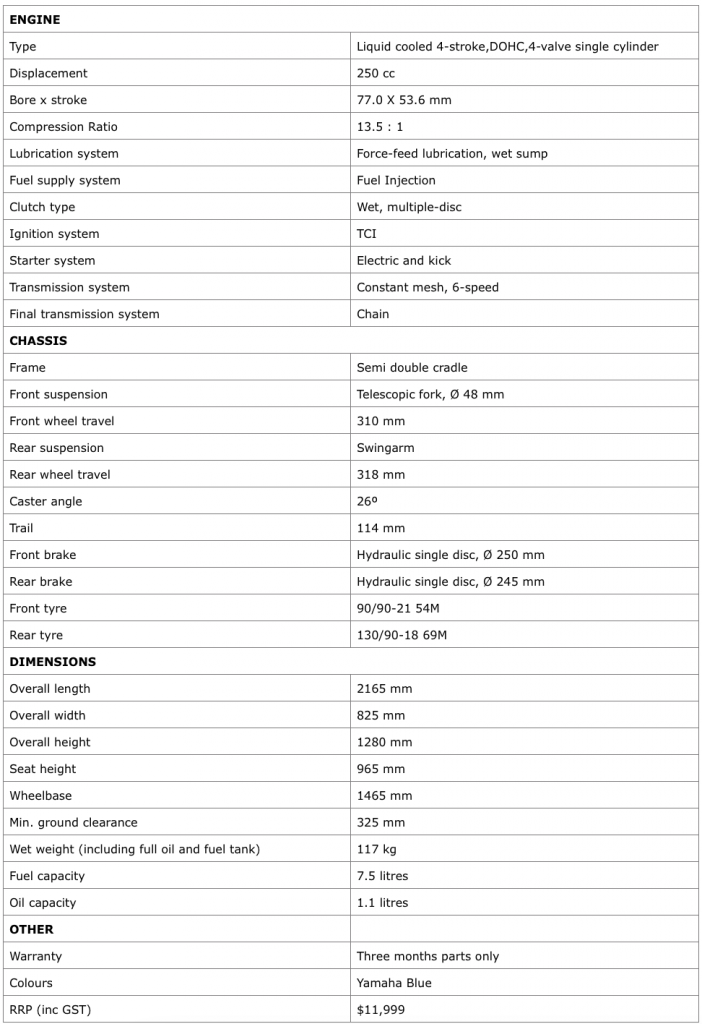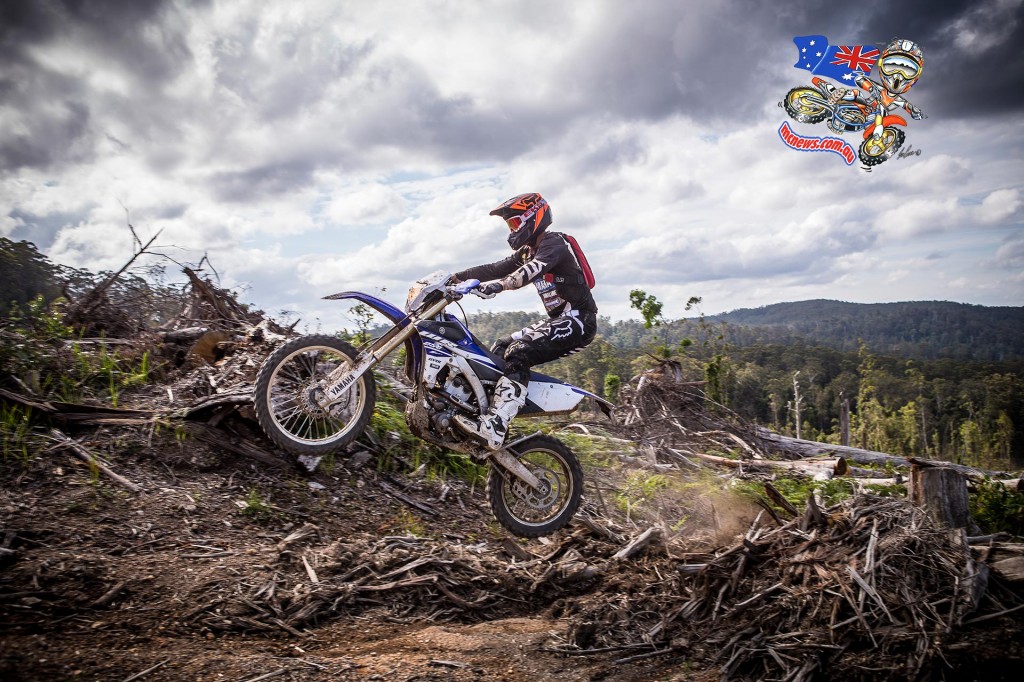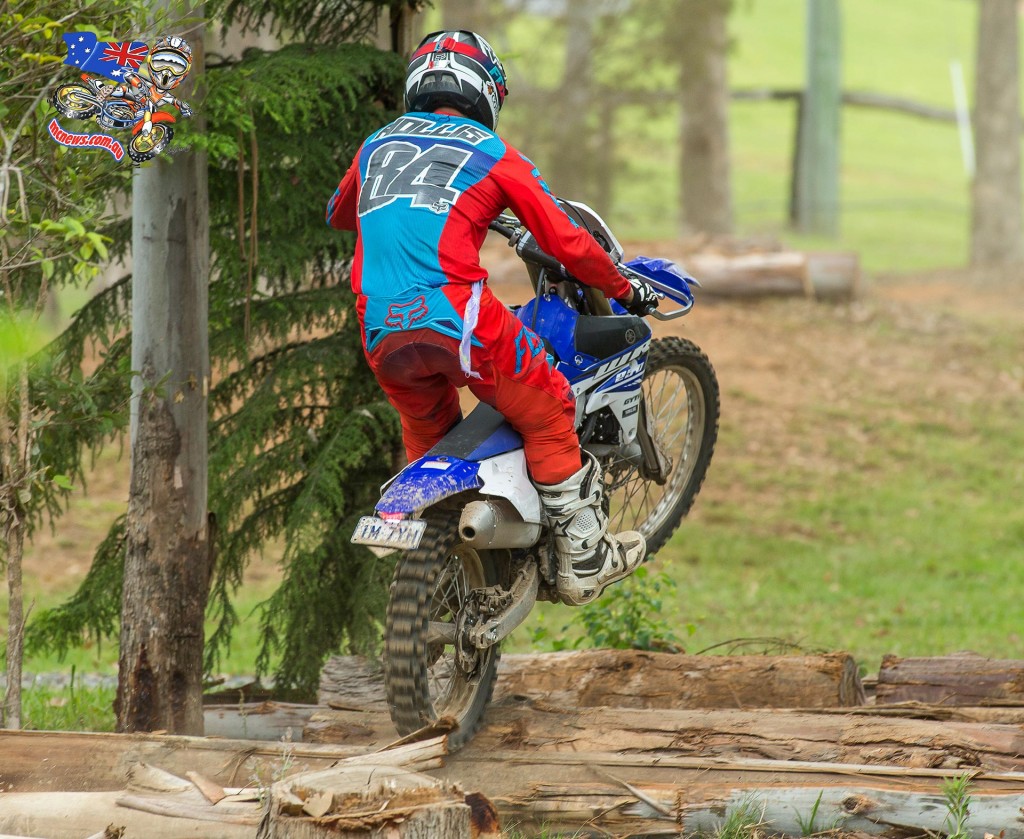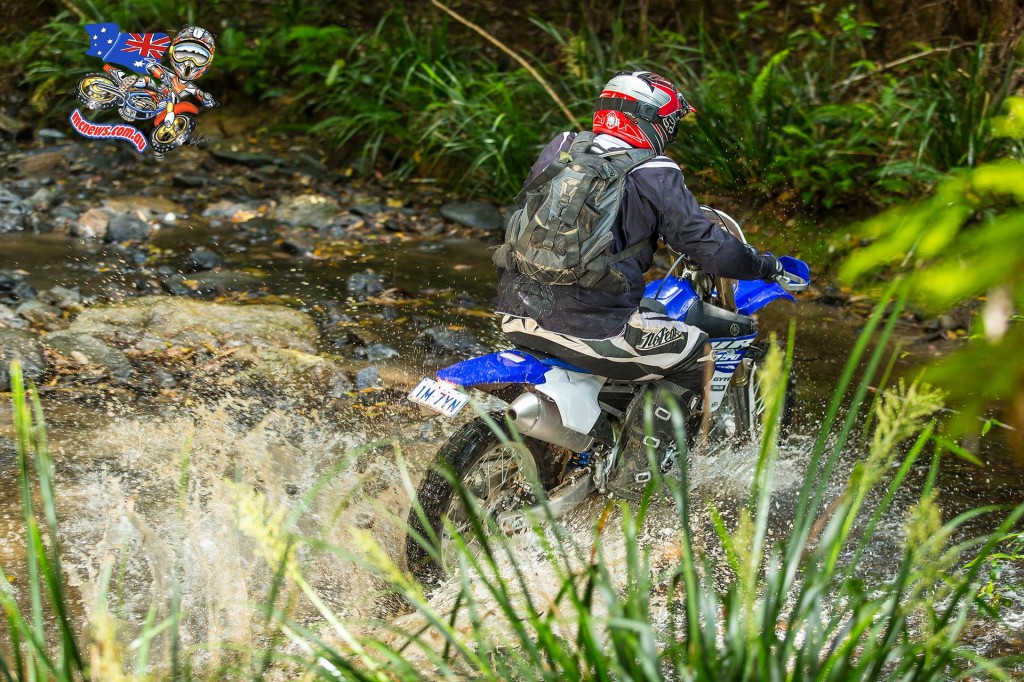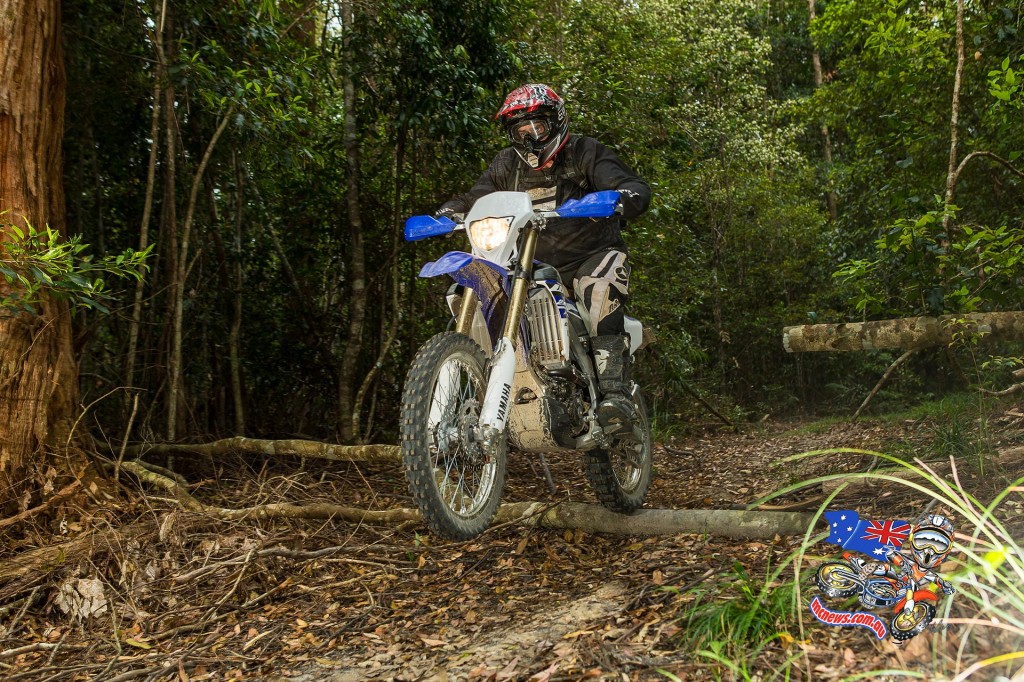2015 Yamaha WR250F Review – By Trevor Hedge
Yamaha’s WR is a pretty big deal to Australian off-road enthusiasts. We buy more of them than any other nationality in the world.
The original four-stroke WR range was the brainchild of a Yamaha Australia triumvirate consisting of Steven Cotterell, Peter Payne and Geoff Ballard. That trio devised and created their own prototype WR to show management back in Japan. To their credit, Yamaha Japan took the advice onboard and went on to essentially invent the modern high-performance four-stroke enduro category that is now the backbone of the enduro scene worldwide.
The 2015 Yamaha WR250F is the first big update to the WR250F since 2007, and it is clear Yamaha have done a lot more than throw an electric starter on the YZ250F motocrosser to come up with what is perhaps the new 250cc enduro benchmark.
In this latest WR250F, which is essentially an enduro variation on Yamaha’s hugely successful 2014 YZ250F, there has also been a lot of homegrown development done over a long period of time to arrive at what Yamaha Australia believes is the perfect recipe for the Aussie bush.
Yamaha Australia’s Peter Payne and Kiwi top gun Josh Coppins spent a lot of time in America, putting development mules through their paces alongside Japanese engineers, adapting the machine for our market. Much of the terrain was purposely chosen for its likeness to Australian conditions and the pair worked hard to arrive at suspension settings that serve as the best compromise across various rider skill levels, sizes and terrain.
There is more YZ DNA in the WR than perhaps ever before. Only what really needed to be changed or tweaked to make the YZ a better enduro bush weapon was changed, everything else is left pure YZ.
The reverse cylinder head (intake at the front, exhaust out the back), rearward slanted YZ250F engine makes it across virtually unchanged to the WR. Compression ratio, cam, titanium valves, twin-ring forged piston and carburised crankshaft are all identical to the motocross machine. The reliability in motocross has already been proven and it is fair to say that modern WR machiney has an enviable reliability record.
Oil capacity in the wet sump is enlarged to 1100ml (200ml more than YZ) to help extend oil service intervals. A six-speed (YZ has five cogs) wide-ratio transmission is mated to a heavier duty clutch better suited to the rigours of enduro use.
To reliably power the lights, electric starter and radiator fan, a 14v 160 amp generator has also been added. The lights are the proven units from the recently updated WR450F. With more than a dozen riders in close company throughout the epic two-day launch program not one light was broken. The excellent instrumentation panel is also carried across from the WR450F.
The bilateral alloy beam frame is essentially the same as the YZ250F except for different engine mounts that Yamaha tell us are better suited to enduro purposes.
The 48mm dual-chamber forks of the YZ250F are a huge improvement over the relatively basic suspension that has previously graced the front end of the WR. The fork springs are two rates lighter than the YZ with corresponding changes to the valving to better suit bush use. Likewise the rear shock design is the same as the YZ250F, but with spring/valving changes and 10mm more travel than the YZ.
The fork leg lowers are changed slightly to accommodate a speedo drive with improved fork covers and a higher triple clamp with adjustable bar mounts. An 18-inch rear rim is also specified and is wider than the motocross machine’s 19-inch rim. The WR250F is shod with Metzler 6 Days Extreme FIM rubber.
Brakes are also beefed up for WR guise with the previous generation WR rear disc and caliper carried across to the new model but mated to the current YZ master cylinder.
The only thing from the YZ250F that perhaps needed changing to prove a real boon to bush riders is to add a couple of litres more capacity to the centrally positioned 7.5 litre fuel cell. Obviously this would require a huge re-engineering effort, and may take away that sublime YZ-derived balance that the WR enjoys. Yamaha figures that riders who really need a lot more capacity will soon be catered for by the aftermarket industry.
It should also be noted that our WR250F differs from the American version, the Yanks have different fuel maps to cater for their stricter regulations and a few other changes. The Australian developed version is identical to what European markets will receive, and also includes the option of the handheld EFI power tuner facility, while we believe the American version is not handheld tuner compatible due to emissions regulations. The optional handheld tuner allows riders to tune the fuel injection and ignition settings themselves, to suit their preferred response, and to also cater for aftermarket exhausts and other modifications. You can also store your preferred maps for various types of terrain, and then quickly load those different maps by plugging the smartphone sized device into the WR.
Enough with the tech stuff let’s see how this baby rides
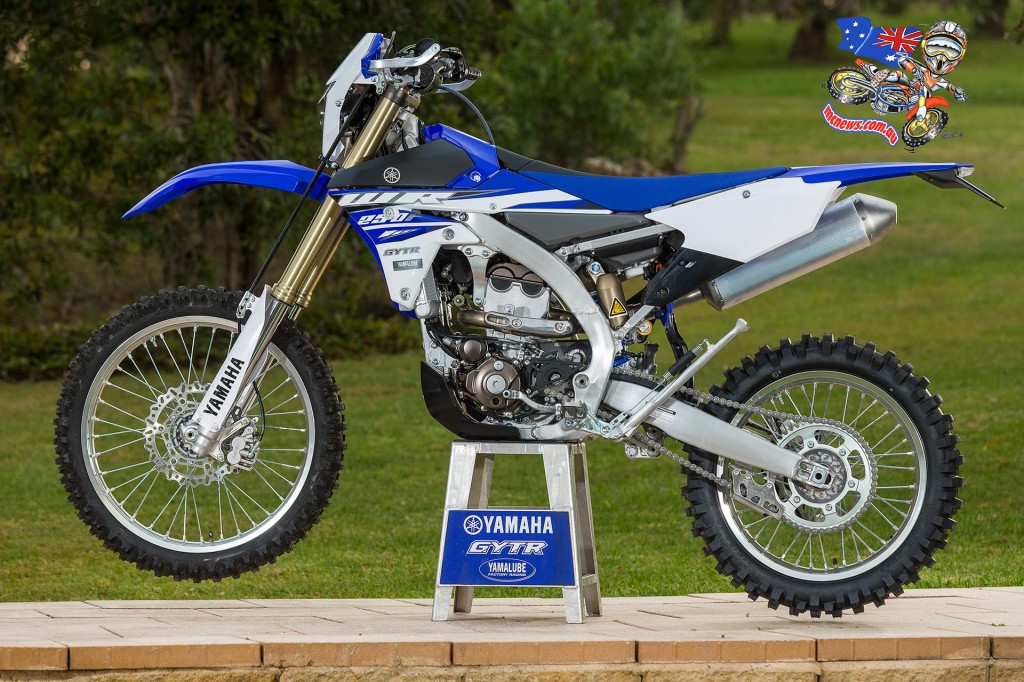
To say I was out of my depth riding with the likes of Chris Hollis, Josh Green and AJ Roberts in very challenging terrain would be an understatement. But then just about every one else is also… Well seasoned off-road specialists on the launch remarked that a lot of the trails we covered across the two-days were more technical than what you generally find in an AORC round, and were more akin to A4DE type terrain. Later I found out that much of the single-track had been used for an A4DE ran out of Coffs Harbour in 2007.
To be honest, I spent a lot of the time shitting myself, particularly at first as the terrain was much more challenging than I am accustomed to, and thus rode very cautiously. There is no point pretending to be good in such company, when at every obstacle you are clearly shown up to be only an average level weekend warrior. That said, I have an enduro bike (yes one I paid for), and have a vast amount of riding under my belt on bigger adventure style bikes, and as such am far from a dirt novice, but the technical nature of the two-day launch certainly pushed me way out of my comfort zone.
Thankfully the WR250F helped carry my 100kg frame over all those challenges and obstacles without once hitting a false neutral, one stall, or a single crash. Pretty much all the well seasoned off-road nutters on the ride did throw it away at least once, including the Pro enduro riders, but my lack of testicular fortitude in such environs kept me upright and helped me to stay in one piece.
On day one I did find that the front end had a slight tendency to tuck more than I preferred. Winding up the preload on the rear shock did bring the handling back to something more neutral but someone approaching triple-digits on the scales will clearly benefit from a stiffer rear spring. An easy $250 fix for us big fellas supplied and fitted at any reputable suspension shop, and while you are there they can set your sag up and get you dialled right into the machine. I also backed the compression damping off on the forks a little which made it ride a little better, for me.
Apart from my wide-load foibles the suspension package of the WR250F proved absolutely brilliant. Even the pros were not bottoming the machine out as they slammed off berms and obstacles in ways that no normal rider will ever manage without leaving the scene on a stretcher. The damping control was responsive and consistent, suggesting that Payne and Coppins did in fact manage to arrive at what is probably the best compromise for most punters.
Tipping the scales at 117kg including all fluids and a full tank of fuel, the WR250F never felt heavy. The central location of the fuel cell, the slanted engine and the concentration of mass as central as possible all do their bit to help the WR feel so light and agile.
Chris Hollis, Tom McCormack and AJ Roberts made the WR look like a mountain bike through some of the tight stuff, bastards. And they were having some pretty hard core fun along the way, pulling up together in clouds of dust laughing between themselves at their thrills and spills, after blasting through the bush at a pace that was simply ridiculous.
At one point I was behind Hollis as he negotiated a very tight change of direction between trees, he just pushed the bike down either way and an instant he was on the gas out the other side. I struggled to get through the same section at walking pace, with the bars on full lock one way, and then the other, the handguards brushing the trunks of the trees, it was t-i-g-h-t. I wanted to see a replay of how Hollis did it played back in slow motion, as it really did defy belief. As much as they make you feel like a complete gumby, riding with such talented racers is the best part of my job, as I get to see up close and personal just how good they really are. Of course, they are all a bit mental too.
One slight annoyance I found as I adapted to the machine was the high idle while in gear that made it hard to effectively rely on the engine braking when pussyfooting it down steep and loose descents. When put in gear the WR automatically raises it’s idle a few hundred rpm to a point probably closer to 2000rpm than 1500rpm. Of course, you can adjust this quite easily but instead I concentrated on trying to adapt and work out why Yamaha had made the idle that high as standard.
The upside of the high idle, when in gear, was an uncanny resistance to stalling, which for an engine that obviously sports such lightweight internals was truly quite amazing. This trait also helped uphill as the WR250F tractored up some seriously challenging climbs in a way that defied belief.
Unlike the mountain goat experts I generally wimp out on the larger erosion bank jumps that litter serious ascents and lose a huge amount of momentum as a result, but the WR250F in second gear, with a little slip of the featherlight clutch when needed, just kept on motoring and dragged my scared little, okay big, arse up every challenge. Thus, again, its a good balance between resistance to stalling and engine braking and I should just not be such a wimp on the descents. But if you are accustomed to 450 levels of engine braking you won’t find them here, the YZ is almost two-stroke like in regards to engine braking when compared against a big-bore thumper. It is just a matter of using better braking technique and adapting. However, there is just enough drag on the rear wheel during corner entry to keep the rear tyre tracking your chosen line, and thus is less likely to break away on entry in comparison to a two-stroke machine.
If you have ever doubted the brilliant tractability that modern day EFI can bring to dirtbikes one technical ride on the WR250F will quickly cure you of any technophobia you may harbour.
The gearbox seemed to offer the perfect ratio for every bush scenario but long transport stages are tiresome at any more than 100km/h on the standard 13-50 gearing. Shifts are faultless.
A modest bashplate, sturdy handguards and lightweight sidestand are also fitted to the WR. None of the launch machines sustained any significant damage, thus while fitting sturdy alloy wraparound bashplates etc. will add peace of mind, they will of course add more weight to the machine. I would be tempted to leave well enough alone and invest my money on off-road adventures instead.
Should I upgrade from my previous WR250F?
There is no doubt whatsoever that the new bike is more balanced, easier to ride and a much sharper scalpel for carving through the bush.
The EFI is brilliant and plays a big part in the massive step forwards in driveability that the new bike enjoys. The motor is so much better, everywhere, all the time.
The quality and response of the suspension is also a big leap over what we have seen before on this model. The fact that it worked extremely well across the wide variety of riders sizes and skill levels is a testament to the inherent quality of the package.
Did I ever want the instant thrust of the 450 I have at home?
Sometimes, rarely, I would have liked to have had a burst of grunt to more easily pull a mono or step the rear out on instant command but in reality I was kidding myself. I would never have successfully completed the ride without crashing my carburetted 450, a lot. Despite being on the larger side of what most people would call ‘fit’, I do a lot of cycling with some big climbs and reasonable distances, and thus am much fitter than what appearances may suggest. As a result I pulled up quite well from the two days and was ready for more. Again, the 450 would have destroyed me physically across the same terrain.
Maintenance and warranty?
The air filter is situated right at the front of the machine, up behind the headstock, and is easily accessed. Oil and filter changes would be an asbolute breeze. As it is a competiton based machine Yamaha offer only a three-month warranty. The rear sub-frame is removeable which is good as when you inevitably crash the crapper out of it and bend it, you can simply bolt on a new one relatively simply, and cheaply.
Would I own one?
In a heartbeat, and, rear spring aside, I would likely not change a damn thing on it for quite some time. Sure, I would like more fuel range than the 120-140km that the 7.5 litre fuel cell provides, but this is a bike made for hard core single track excursions and enduro competition, thus if you really do need a much larger fuel range it is likely the wrong bike for you anyway. Aftermarket suppliers will be quick on the case to satisfy any customisation whim your heart desires, and your wallet allows for.
How much?
The price of admission to WR250F goodness is $11,999 and the bike comes with the competition kit, as fitted to the bikes we tested, included as part of the purchase price.
Want to ride the terrain we did?
Boris from Coffs Harbour Detour put the ride together and has also previously set A4DE courses. If you want to get out with Coffs Harbour Detour chekc them out via this link.
A more hard core WR250F?
Yamaha are also set to releaase a YZ250FX model which is effectively the same as the WR250F but without all the road gear such as lights, thus is only eligible for forest use in states that have a liberal Recreational Rego scheme, such as Victoria. The YZ250FX also does away with the fan and speedo, and sports slightly stiffer suspension than the WR. We get to test the $11,499 YZ250FX shortly in Queenstown, NZ. It’s a tough job, but someone has to do it…. Continue below for the launch video, technical specifications and a gallery of detail images that get up close and personal with the 2015 Yamaha WR250F.
Launch Video
[youtube id=”6xaJyh12Fx4″ width=”853″ height=”480″]
